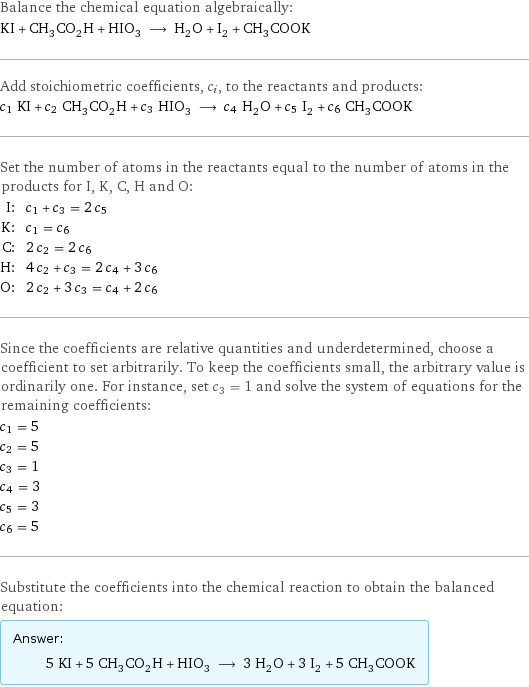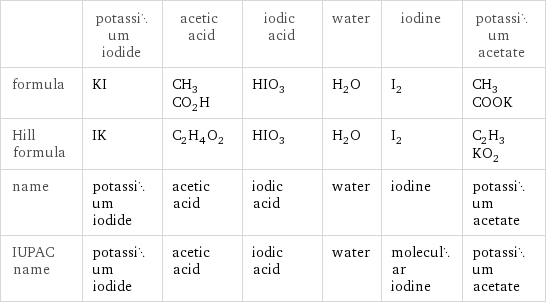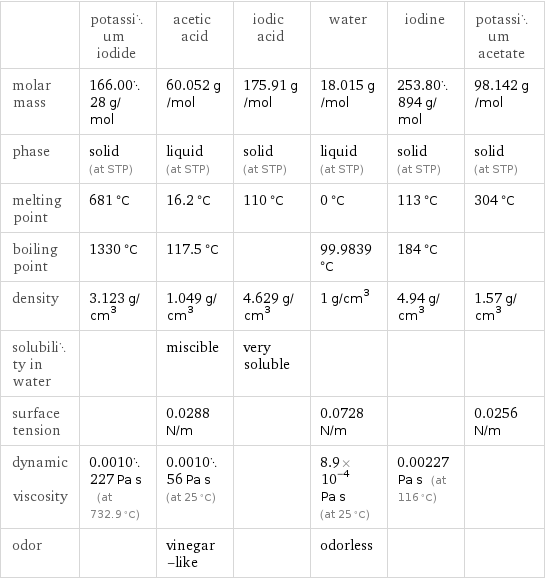Input interpretation

KI potassium iodide + CH_3CO_2H acetic acid + HIO_3 iodic acid ⟶ H_2O water + I_2 iodine + CH_3COOK potassium acetate
Balanced equation

Balance the chemical equation algebraically: KI + CH_3CO_2H + HIO_3 ⟶ H_2O + I_2 + CH_3COOK Add stoichiometric coefficients, c_i, to the reactants and products: c_1 KI + c_2 CH_3CO_2H + c_3 HIO_3 ⟶ c_4 H_2O + c_5 I_2 + c_6 CH_3COOK Set the number of atoms in the reactants equal to the number of atoms in the products for I, K, C, H and O: I: | c_1 + c_3 = 2 c_5 K: | c_1 = c_6 C: | 2 c_2 = 2 c_6 H: | 4 c_2 + c_3 = 2 c_4 + 3 c_6 O: | 2 c_2 + 3 c_3 = c_4 + 2 c_6 Since the coefficients are relative quantities and underdetermined, choose a coefficient to set arbitrarily. To keep the coefficients small, the arbitrary value is ordinarily one. For instance, set c_3 = 1 and solve the system of equations for the remaining coefficients: c_1 = 5 c_2 = 5 c_3 = 1 c_4 = 3 c_5 = 3 c_6 = 5 Substitute the coefficients into the chemical reaction to obtain the balanced equation: Answer: | | 5 KI + 5 CH_3CO_2H + HIO_3 ⟶ 3 H_2O + 3 I_2 + 5 CH_3COOK
Structures

+ + ⟶ + +
Names

potassium iodide + acetic acid + iodic acid ⟶ water + iodine + potassium acetate
Equilibrium constant
![Construct the equilibrium constant, K, expression for: KI + CH_3CO_2H + HIO_3 ⟶ H_2O + I_2 + CH_3COOK Plan: • Balance the chemical equation. • Determine the stoichiometric numbers. • Assemble the activity expression for each chemical species. • Use the activity expressions to build the equilibrium constant expression. Write the balanced chemical equation: 5 KI + 5 CH_3CO_2H + HIO_3 ⟶ 3 H_2O + 3 I_2 + 5 CH_3COOK Assign stoichiometric numbers, ν_i, using the stoichiometric coefficients, c_i, from the balanced chemical equation in the following manner: ν_i = -c_i for reactants and ν_i = c_i for products: chemical species | c_i | ν_i KI | 5 | -5 CH_3CO_2H | 5 | -5 HIO_3 | 1 | -1 H_2O | 3 | 3 I_2 | 3 | 3 CH_3COOK | 5 | 5 Assemble the activity expressions accounting for the state of matter and ν_i: chemical species | c_i | ν_i | activity expression KI | 5 | -5 | ([KI])^(-5) CH_3CO_2H | 5 | -5 | ([CH3CO2H])^(-5) HIO_3 | 1 | -1 | ([HIO3])^(-1) H_2O | 3 | 3 | ([H2O])^3 I_2 | 3 | 3 | ([I2])^3 CH_3COOK | 5 | 5 | ([CH3COOK])^5 The equilibrium constant symbol in the concentration basis is: K_c Mulitply the activity expressions to arrive at the K_c expression: Answer: | | K_c = ([KI])^(-5) ([CH3CO2H])^(-5) ([HIO3])^(-1) ([H2O])^3 ([I2])^3 ([CH3COOK])^5 = (([H2O])^3 ([I2])^3 ([CH3COOK])^5)/(([KI])^5 ([CH3CO2H])^5 [HIO3])](../image_source/e1693ef842d3a4bb116193f1651d14bd.png)
Construct the equilibrium constant, K, expression for: KI + CH_3CO_2H + HIO_3 ⟶ H_2O + I_2 + CH_3COOK Plan: • Balance the chemical equation. • Determine the stoichiometric numbers. • Assemble the activity expression for each chemical species. • Use the activity expressions to build the equilibrium constant expression. Write the balanced chemical equation: 5 KI + 5 CH_3CO_2H + HIO_3 ⟶ 3 H_2O + 3 I_2 + 5 CH_3COOK Assign stoichiometric numbers, ν_i, using the stoichiometric coefficients, c_i, from the balanced chemical equation in the following manner: ν_i = -c_i for reactants and ν_i = c_i for products: chemical species | c_i | ν_i KI | 5 | -5 CH_3CO_2H | 5 | -5 HIO_3 | 1 | -1 H_2O | 3 | 3 I_2 | 3 | 3 CH_3COOK | 5 | 5 Assemble the activity expressions accounting for the state of matter and ν_i: chemical species | c_i | ν_i | activity expression KI | 5 | -5 | ([KI])^(-5) CH_3CO_2H | 5 | -5 | ([CH3CO2H])^(-5) HIO_3 | 1 | -1 | ([HIO3])^(-1) H_2O | 3 | 3 | ([H2O])^3 I_2 | 3 | 3 | ([I2])^3 CH_3COOK | 5 | 5 | ([CH3COOK])^5 The equilibrium constant symbol in the concentration basis is: K_c Mulitply the activity expressions to arrive at the K_c expression: Answer: | | K_c = ([KI])^(-5) ([CH3CO2H])^(-5) ([HIO3])^(-1) ([H2O])^3 ([I2])^3 ([CH3COOK])^5 = (([H2O])^3 ([I2])^3 ([CH3COOK])^5)/(([KI])^5 ([CH3CO2H])^5 [HIO3])
Rate of reaction
![Construct the rate of reaction expression for: KI + CH_3CO_2H + HIO_3 ⟶ H_2O + I_2 + CH_3COOK Plan: • Balance the chemical equation. • Determine the stoichiometric numbers. • Assemble the rate term for each chemical species. • Write the rate of reaction expression. Write the balanced chemical equation: 5 KI + 5 CH_3CO_2H + HIO_3 ⟶ 3 H_2O + 3 I_2 + 5 CH_3COOK Assign stoichiometric numbers, ν_i, using the stoichiometric coefficients, c_i, from the balanced chemical equation in the following manner: ν_i = -c_i for reactants and ν_i = c_i for products: chemical species | c_i | ν_i KI | 5 | -5 CH_3CO_2H | 5 | -5 HIO_3 | 1 | -1 H_2O | 3 | 3 I_2 | 3 | 3 CH_3COOK | 5 | 5 The rate term for each chemical species, B_i, is 1/ν_i(Δ[B_i])/(Δt) where [B_i] is the amount concentration and t is time: chemical species | c_i | ν_i | rate term KI | 5 | -5 | -1/5 (Δ[KI])/(Δt) CH_3CO_2H | 5 | -5 | -1/5 (Δ[CH3CO2H])/(Δt) HIO_3 | 1 | -1 | -(Δ[HIO3])/(Δt) H_2O | 3 | 3 | 1/3 (Δ[H2O])/(Δt) I_2 | 3 | 3 | 1/3 (Δ[I2])/(Δt) CH_3COOK | 5 | 5 | 1/5 (Δ[CH3COOK])/(Δt) (for infinitesimal rate of change, replace Δ with d) Set the rate terms equal to each other to arrive at the rate expression: Answer: | | rate = -1/5 (Δ[KI])/(Δt) = -1/5 (Δ[CH3CO2H])/(Δt) = -(Δ[HIO3])/(Δt) = 1/3 (Δ[H2O])/(Δt) = 1/3 (Δ[I2])/(Δt) = 1/5 (Δ[CH3COOK])/(Δt) (assuming constant volume and no accumulation of intermediates or side products)](../image_source/5a1cb0933eaa715dd74b53312ea9a64b.png)
Construct the rate of reaction expression for: KI + CH_3CO_2H + HIO_3 ⟶ H_2O + I_2 + CH_3COOK Plan: • Balance the chemical equation. • Determine the stoichiometric numbers. • Assemble the rate term for each chemical species. • Write the rate of reaction expression. Write the balanced chemical equation: 5 KI + 5 CH_3CO_2H + HIO_3 ⟶ 3 H_2O + 3 I_2 + 5 CH_3COOK Assign stoichiometric numbers, ν_i, using the stoichiometric coefficients, c_i, from the balanced chemical equation in the following manner: ν_i = -c_i for reactants and ν_i = c_i for products: chemical species | c_i | ν_i KI | 5 | -5 CH_3CO_2H | 5 | -5 HIO_3 | 1 | -1 H_2O | 3 | 3 I_2 | 3 | 3 CH_3COOK | 5 | 5 The rate term for each chemical species, B_i, is 1/ν_i(Δ[B_i])/(Δt) where [B_i] is the amount concentration and t is time: chemical species | c_i | ν_i | rate term KI | 5 | -5 | -1/5 (Δ[KI])/(Δt) CH_3CO_2H | 5 | -5 | -1/5 (Δ[CH3CO2H])/(Δt) HIO_3 | 1 | -1 | -(Δ[HIO3])/(Δt) H_2O | 3 | 3 | 1/3 (Δ[H2O])/(Δt) I_2 | 3 | 3 | 1/3 (Δ[I2])/(Δt) CH_3COOK | 5 | 5 | 1/5 (Δ[CH3COOK])/(Δt) (for infinitesimal rate of change, replace Δ with d) Set the rate terms equal to each other to arrive at the rate expression: Answer: | | rate = -1/5 (Δ[KI])/(Δt) = -1/5 (Δ[CH3CO2H])/(Δt) = -(Δ[HIO3])/(Δt) = 1/3 (Δ[H2O])/(Δt) = 1/3 (Δ[I2])/(Δt) = 1/5 (Δ[CH3COOK])/(Δt) (assuming constant volume and no accumulation of intermediates or side products)
Chemical names and formulas

| potassium iodide | acetic acid | iodic acid | water | iodine | potassium acetate formula | KI | CH_3CO_2H | HIO_3 | H_2O | I_2 | CH_3COOK Hill formula | IK | C_2H_4O_2 | HIO_3 | H_2O | I_2 | C_2H_3KO_2 name | potassium iodide | acetic acid | iodic acid | water | iodine | potassium acetate IUPAC name | potassium iodide | acetic acid | iodic acid | water | molecular iodine | potassium acetate
Substance properties

| potassium iodide | acetic acid | iodic acid | water | iodine | potassium acetate molar mass | 166.0028 g/mol | 60.052 g/mol | 175.91 g/mol | 18.015 g/mol | 253.80894 g/mol | 98.142 g/mol phase | solid (at STP) | liquid (at STP) | solid (at STP) | liquid (at STP) | solid (at STP) | solid (at STP) melting point | 681 °C | 16.2 °C | 110 °C | 0 °C | 113 °C | 304 °C boiling point | 1330 °C | 117.5 °C | | 99.9839 °C | 184 °C | density | 3.123 g/cm^3 | 1.049 g/cm^3 | 4.629 g/cm^3 | 1 g/cm^3 | 4.94 g/cm^3 | 1.57 g/cm^3 solubility in water | | miscible | very soluble | | | surface tension | | 0.0288 N/m | | 0.0728 N/m | | 0.0256 N/m dynamic viscosity | 0.0010227 Pa s (at 732.9 °C) | 0.001056 Pa s (at 25 °C) | | 8.9×10^-4 Pa s (at 25 °C) | 0.00227 Pa s (at 116 °C) | odor | | vinegar-like | | odorless | |
Units
